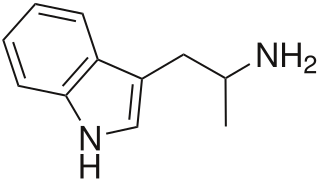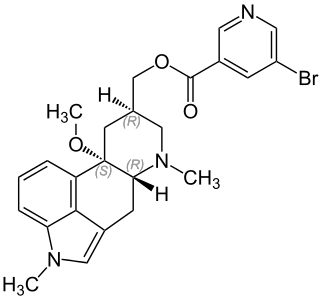Related Research Articles

α-Methyltryptamine is a psychedelic, stimulant, and entactogen drug of the tryptamine family. It was originally developed as an antidepressant at Upjohn in the 1960s, and was used briefly as an antidepressant in the Soviet Union under the brand name Indopan or Indopane before being discontinued.

Phenethylamine (PEA) is an organic compound, natural monoamine alkaloid, and trace amine, which acts as a central nervous system stimulant in humans. In the brain, phenethylamine regulates monoamine neurotransmission by binding to trace amine-associated receptor 1 (TAAR1) and inhibiting vesicular monoamine transporter 2 (VMAT2) in monoamine neurons. To a lesser extent, it also acts as a neurotransmitter in the human central nervous system. In mammals, phenethylamine is produced from the amino acid L-phenylalanine by the enzyme aromatic L-amino acid decarboxylase via enzymatic decarboxylation. In addition to its presence in mammals, phenethylamine is found in many other organisms and foods, such as chocolate, especially after microbial fermentation.

Tryptamine is an indolamine metabolite of the essential amino acid, tryptophan. The chemical structure is defined by an indole—a fused benzene and pyrrole ring, and a 2-aminoethyl group at the second carbon. The structure of tryptamine is a shared feature of certain aminergic neuromodulators including melatonin, serotonin, bufotenin and psychedelic derivatives such as dimethyltryptamine (DMT), psilocybin, psilocin and others.

Oxiracetam is a nootropic drug of the racetam family and a very mild stimulant. Several studies suggest that the substance is safe even when high doses are consumed for a long period of time. However, the mechanism of action of the racetam drug family is still a matter of research. Oxiracetam is not approved by Food and Drug Administration for any medical use in the United States.

Trace amines are an endogenous group of trace amine-associated receptor 1 (TAAR1) agonists – and hence, monoaminergic neuromodulators – that are structurally and metabolically related to classical monoamine neurotransmitters. Compared to the classical monoamines, they are present in trace concentrations. They are distributed heterogeneously throughout the mammalian brain and peripheral nervous tissues and exhibit high rates of metabolism. Although they can be synthesized within parent monoamine neurotransmitter systems, there is evidence that suggests that some of them may comprise their own independent neurotransmitter systems.

Nicergoline, sold under the brand name Sermion among others, is an ergot derivative used to treat senile dementia and other disorders with vascular origins. Internationally it has been used for frontotemporal dementia as well as early onset in Lewy body dementia and Parkinson's dementia. It decreases vascular resistance and increases arterial blood flow in the brain, improving the utilization of oxygen and glucose by brain cells. It has similar vasoactive properties in other areas of the body, particularly the lungs. Unlike many other ergolines, such as ergotamine, nicergoline is not associated with cardiac fibrosis.

Niaprazine (INN) is a sedative-hypnotic drug of the phenylpiperazine group. It has been used in the treatment of sleep disturbances since the early 1970s in several European countries including France, Italy, and Luxembourg. It is commonly used with children and adolescents on account of its favorable safety and tolerability profile and lack of abuse potential.

Norepinephrine (NE), also called noradrenaline (NA) or noradrenalin, is an organic chemical in the catecholamine family that functions in the brain and body as a hormone, neurotransmitter and neuromodulator. The name "noradrenaline" is more commonly used in the United Kingdom, whereas "norepinephrine" is usually preferred in the United States. "Norepinephrine" is also the international nonproprietary name given to the drug. Regardless of which name is used for the substance itself, parts of the body that produce or are affected by it are referred to as noradrenergic.

Ifenprodil, sold under the brand names Cerocral, Dilvax, and Vadilex, is a cerebral vasodilator that has been marketed in some countries, including in Japan, Hong Kong, and France. It is currently under development for treatment of a variety of additional indications.

(–)-Benzofuranylpropylaminopentane is an experimental drug related to selegiline which acts as a monoaminergic activity enhancer (MAE). It is orally active in animals.

5-Fluoro-α-methyltryptamine, also known as PAL-544, is a putative stimulant, entactogen, and psychedelic tryptamine derivative related to α-methyltryptamine (αMT). It has been found to act as a well-balanced serotonin-norepinephrine-dopamine releasing agent, a 5-HT2A receptor agonist, and a potent and specific MAO-A inhibitor. which suggests that 5-fluoro-αMT could be an active psychedelic in humans, although it is not known to have been tested in humans and could be dangerous due to its strong inhibition of MAO-A.

Cinepazide or cinepazide maleate is a vasodilator used in China for the treatment of cardiovascular and cerebrovascular diseases, and peripheral vascular diseases. It appears to work by potentiating A2 adenosine receptors.

Bifemelane (INN) (Alnert, Celeport), or bifemelane hydrochloride (JAN), also known as 4-(O-benzylphenoxy)-N-methylbutylamine, is an antidepressant and cerebral activator that was widely used in the treatment of cerebral infarction patients with depressive symptoms in Japan, and in the treatment of senile dementia as well. It also appears to be useful in the treatment of glaucoma. It has been discontinued in Japan since 1998, when it was removed from the market reportedly for lack of effectiveness.

Indeloxazine (INN) is an antidepressant and cerebral activator that was marketed in Japan and South Korea by Yamanouchi Pharmaceutical Co., Ltd for the treatment of psychiatric symptoms associated with cerebrovascular diseases, namely depression resulting from stroke, emotional disturbance, and avolition. It was marketed from 1988 to 1998, when it was removed from the market reportedly for lack of effectiveness.

para-Chloroamphetamine (PCA), also known as 4-chloroamphetamine (4-CA), is a substituted amphetamine and monoamine releaser similar to MDMA, but with substantially higher activity as a monoaminergic neurotoxin, thought to be due to the unrestrained release of both serotonin and dopamine by a metabolite. It is used as a neurotoxin by neurobiologists to selectively kill serotonergic neurons for research purposes, in the same way that 6-hydroxydopamine is used to kill dopaminergic neurons.

A monoamine releasing agent (MRA), or simply monoamine releaser, is a drug that induces the release of a monoamine neurotransmitter from the presynaptic neuron into the synapse, leading to an increase in the extracellular concentrations of the neurotransmitter. Many drugs induce their effects in the body and/or brain via the release of monoamine neurotransmitters, e.g., trace amines, many substituted amphetamines, and related compounds.
A serotonin releasing agent (SRA) is a type of drug that induces the release of serotonin into the neuronal synaptic cleft. A selective serotonin releasing agent (SSRA) is an SRA with less significant or no efficacy in producing neurotransmitter efflux at other types of monoamine neurons, including dopamine and norepinephrine neurons.

Teniloxazine, also known as sufoxazine and sulfoxazine, is a drug which is marketed in Japan. Though initially investigated as a neuroprotective and nootropic agent for the treatment of cerebrovascular insufficiency in the 1980s, it was ultimately developed and approved as an antidepressant instead. It acts as a potent norepinephrine reuptake inhibitor, with fair selectivity over the serotonin and dopamine transporters, and also behaves as an antagonist of the 5-HT2A receptor.
A cerebral activator, also known as a cerebral metabolic enhancer or activator, is a type of drug that "activates" the central nervous system in the context of cerebrovascular diseases such as stroke and dementia. The term has been used specifically to describe a few Japanese drugs, such as indeloxazine and bifemelane.

para-Chloromethamphetamine is a stimulant that is the N-methyl derivative and prodrug of the neurotoxic drug para-chloroamphetamine (4-CA). It has been found to decrease serotonin in rats. Further investigation into the long-term effects of chloroamphetamines discovered that administration of 4-CMA caused a prolonged reduction in the levels of serotonin and the activity of tryptophan hydroxylase in the brain one month after injection of a single dose of the drug.
References
- 1 2 Toda N, Okamura T (April 1998). "Cerebral vasodilators". Jpn J Pharmacol. 76 (4): 349–367. doi: 10.1254/jjp.76.349 . PMID 9623714.
- 1 2 3 Cook P, James I (December 1981). "Drug therapy: cerebral vasodilators (first of two parts)". N Engl J Med. 305 (25): 1508–1513. doi:10.1056/NEJM198112173052505. PMID 7029283.
- ↑ Yesavage JA, Tinklenberg JR, Hollister LE, Berger PA (February 1979). "Vasodilators in senile dementias: a review of the literature". Arch Gen Psychiatry. 36 (2): 220–223. doi:10.1001/archpsyc.1979.01780020110012. PMID 420543.
- ↑ Egunlusi AO, Joubert J (May 2024). "NMDA Receptor Antagonists: Emerging Insights into Molecular Mechanisms and Clinical Applications in Neurological Disorders". Pharmaceuticals (Basel). 17 (5): 639. doi: 10.3390/ph17050639 . PMC 11124131 . PMID 38794209.
- ↑ Tadano T, Yonezawa A, Oyama K, Kisara K, Arai Y, Togashi M, Kinemuchi H (1995). "Effects of transient global ischemia and a monoamine oxidase inhibitor ifenprodil on rat brain monoamine metabolism". Prog Brain Res. 106: 173–80. doi:10.1016/s0079-6123(08)61213-3. PMID 8584652.
- ↑ Schweizerischer Apotheker-Verein (2004). Index Nominum: International Drug Directory. Medpharm Scientific Publishers. p. 625. ISBN 978-3-88763-101-7 . Retrieved 2 September 2024.
- ↑ Braestrup, C. (2012). Psychotropic Agents: Part II: Anxiolytics, Gerontopsychopharmacological Agents, and Psychomotor Stimulants. Handbook of Experimental Pharmacology. Springer Berlin Heidelberg. pp. 419–420. ISBN 978-3-642-67767-0 . Retrieved 17 October 2024.
- ↑ Fisman M (1981). "Clinical pharmacology of senile dementia". Prog Neuropsychopharmacol. 5 (5–6): 447–457. doi:10.1016/0364-7722(81)90026-6. PMID 6122228.
- ↑ Yamamoto, M; Kawabata, S; Shimizu, M (1989). "Pharmacological effects of indeloxazine, a new cerebral activator, on brain functions distinct from other cerebral metabolic enhancers". Neuropharmacology. 28 (12): 1291–1297. doi:10.1016/0028-3908(89)90001-4. ISSN 0028-3908. PMID 2615913. S2CID 10028363.
- ↑ Takahashi, Koichiro; Yamamoto, Minoru; Suzuki, Masanori; Ozawa, Yukiko; Yamaguchi, Takashi; Andoh, Hirofumi; Ishikawa, Kouichi (1995). "Effects of cerebral metabolic enhancers on brain function in rodents". Current Therapeutic Research. 56 (5): 478–485. doi:10.1016/0011-393X(95)85080-5. ISSN 0011-393X.
- ↑ van Reekum R, Black SE, Conn D, Clarke D (1997). "Cognition-enhancing drugs in dementia: a guide to the near future". Can J Psychiatry. 42 (Suppl 1): 35S–50S. PMID 9220128.